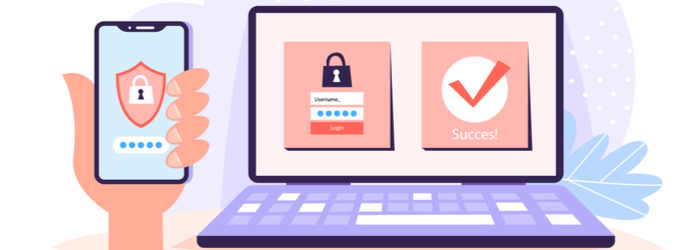Over the years, incidents of cybercrime have been on the rise, with new hacking techniques coming up all the time. In 2020, hackers attacked 61% of organizations, and the business world lost $1 trillion due to cybercrime.
To protect yourself and your business from such attacks, you need a reliable verification system. In this blog we’ll discuss one such approach known as multi-factor authentication (MFA).
What Is Multi-Factor Authentication?
MFA is a multiple-step process you go through before accessing an online account. Instead of just asking for a username and password, MFA takes further strategic steps to determine whether you’re the account’s legitimate owner.
These measures require you to give additional information which no one else is likely to know. Doing so minimizes the chances of another person accessing your account.
How Multi-Factor Authentication Works
MFA uses three sets of additional information to strengthen your account’s security.
- Something that’s known only to you, such as password or PIN
- Something that’s in your possession, such as a card or a smartphone
- Something that’s part of you, such as fingerprints or voice
The authentication process begins by asking you something that you know. In almost all cases, this involves a password or a PIN. But passwords have become susceptible to attacks due to the increased number of password cracking tools. To counter this concern, some systems may ask you one or a few security questions. Since you’re the only one who knows the answers, the steps limit the risk of a security breach or loss of sensitive information.
In addition to the things you know, MFA can use your possessions for authentication. For instance, the system can send you a one-time password (OTP) to your phone. At that point, you can enter this OTP manually, or your phone can detect it automatically.
Bearing in mind you must have your phone at that moment to access the OTP, it’s less likely anyone else can breach this step.
Lastly, MFA can use your biological traits as part of authentication. Often, this involves fingerprints, voice recognition, face recognition, and eye scanning.
Other Types of Multi-Factor Authentication
Sometimes MFA can use your location as part of the verification process. The system does this using your IP address or your geolocation. Assuming someone attempts to access your account from an unfamiliar location, the system proceeds to ask additional questions or block access.
Risk-based authentication, also known as adaptive authentication, ensures security by monitoring any suspicious activities. These actions may include:
- Accessing the account in unusual hours and locations
- Using a different device to access the account
- Using an unfamiliar network or a VPN
If the system detects medium risk, you’ll take a few more steps before successfully accessing your account. But if there’s a significant risk, the system will block access.
Why is Multi-Factor Authentication Important?
MFA acts as a preventive measure to protect one of the most valuable assets of an organization, data. A strong access management policy curbs information loss through ransomware and works to maintain data integrity.
Whether you want to access a VPN, an email, or an application, multi-factor authentication is an effective strategy of ensuring maximum security when accessing these accounts. To learn more, ask us about an IT Strategy & Risk Assessment for your business.






